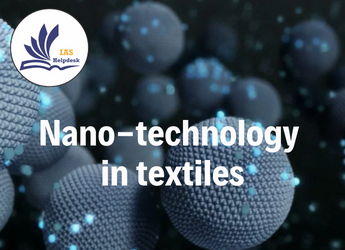Nanotechnology in Textiles
Description
Nanotechnology in Textiles
Nanotechnology is being applied in various fields due to its ability to change physical, chemical, electronic, optical, thermal, magnetic, and biological properties of the matter because of its ultra-small size of less than 100 nm (1 nm = 1 part of 10 lakh equal parts of 1 mm).
Some applications in textile sector are discussed below:
a) Antibacterial clothing
• Scientists have developed a nanosilver-based suspension that can be applied on the fabric surface to get antibacterial activity. In the silver nanoparticles, Ag+ ions released from the surface interact with the bacterial cell membrane, proteins in the cell, and DNA which leads to cell death.
• Other compounds such as zinc, copper, and their oxides coupled with metal nanoparticles can also be used as antibacterial agents. Recently, ARCI has demonstrated coating of copper oxide nanoparticles doped with a trace amount of silver in the active layer in the face mask to give protection against the SARS-CoV-2 virus.
• Titanium dioxide is another strong antimicrobial material that conducts the phenomenon known as “Photocatalysis” (absorbs ultraviolet rays in sunlight).
It can be used in:
o Daily wear clothes as it become a host for bacteria to grow in the sweat absorbed by the fabric, giving out a bad odour
o Medical sector, especially in the present deadly pandemic conditions
o Sportswear, baby products, sanitary napkins, wound healing dressings, etc
b) Self-cleaning
• titanium dioxide can clean the organic pollutants just by giving sunlight exposure for few hours. This technology saves detergent, water, and electricity simply, we just have to wear these clothes and breathe fresh air
• The same titania is also very effective against giving protection from harmful UV rays in sunlight. ‘Wearable Sunscreen’ tagged garments in the market are based on this property of titania microspheres.
c) Thermoregulation
• Thermoregulation, where fabric responds to changes in the body temperature and maintains comfort by either heating or cooling. The Phase Change Material (PCM) is incorporated into the fabric to fulfill this function.
d) Stain and wrinkle resistance
• The synthetic fibers develop a static charge. The anti-static property can be imparted on them by coating hydrophilic nano-sized oxide particles like titanium dioxide, zinc oxide, Antimony Tin Oxide (ATO), silica, or bonding electrically conducting nanoparticles which can effectively dissipate the static charge which is accumulated on the fabric.
e) Technical Textiles
• fireproof and flame retardant fabric is required in the suit used by firefighters. The high-temperature stable materials are combined with thermally insulating and fireproof materials such as nanoporous silica aerogel for this application
• personnel working at subzero temperatures need protection against low temperatures in their clothing, tents, food storage, etc. The same silica aerogel can serve this purpose because of its thermal insulation property for cold temperatures too.
• The fabric can be used as a sensor or charger by functionalising with Piezoelectric nanocrystals which can convert mechanical load into electrical energy. This electrical signal can be used to sense a heartbeat or to charge a small battery
• Other examples of technical textiles include functions like electromagnetic field shielding, electrical conducting, anti-static, camouflaging, stealth, water repellency, and so on.
Nanotechnology has great potential in the textile industry. Functional and smart textiles can play an important role in the economy of the nation. However, there are limitations in applications, complexity and the cost adhered to it. A proper study is necessary to find any toxic effects of handling or wearing the nanomaterials to eliminate any health risks due to short or long-time exposure. For example, nanosilver application on textiles was studied for leaching of silver in water while washing the fabric.

